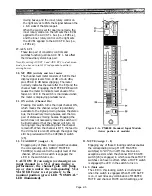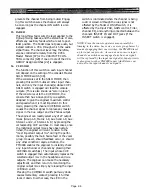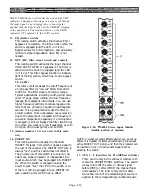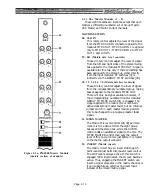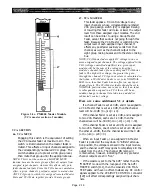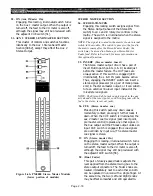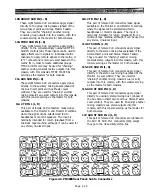
Figure 2-3c. PM4000 Master Module
(VCA master section of module)
VCA SECTION
46. VCA MUTE
Engaging this switch is the equivalent of setting
the VCA master fader at maximum kill. The
switch is illuminated when the master fader is
muted. This affects all input channels assigned to
the correspondingly numbered VCA group. The
switch enables you to preset a VCA group level,
then mute that group until the appropriate cue.
NOTE: This is not the same as a MASTER MUTE
function because the mute groups affect all outputs from
assigned input channels, whereas this affects only post-
fader channel outputs. Since the VCAs have a cumulative
effect, a given channel’s post-fader output is muted when
ANY VCA group to which it is assigned is muted. Master
Mute and VCA Mute together provide 16 mute groups.
47. VCA MASTER
This fader applies a DC control voltage to any
input channels whose correspondingly-numbered
VCA group assign switch [22] is engaged. Raising
or lowering this fader will raise or lower the output
level from those assigned input modules. The end
result can be similar to using a Group Master
Fader, except that audio is not going through this
fader. Because the VCA Master is controlling the
output level of each assigned input channel, it
affects any post-fader auxiliary sends from that
channel, as well as the channel’s output to the
eight group mixing busses and to the stereo mixing
bus.
NOTE: VCA Master faders apply DC voltage to one or
more assigned input channels. The voltage applied to the
VCA (voltage controlled amplifier) in a given input
module will be the sum of the voltages from that
module’s channel fader, plus any assigned VCA Master
faders. The higher the voltage, the greater the gain
through the channel. VCA gain structure is calculated so
that when a VCA Master Fader is set so its NOMINAL
LED is on, then that Fader has no affect on any input
channel levels. The VCA Master faders should be set to
NOMINAL position when not in use so that if an input
is subsequently assigned to a VCA, there will be no
sudden change in channel level due to an added (or
subtracted) control voltage.
Here are some additional VCA details
If a channel Fader is set at 0 dB, and it is assigned to
a VCA Master that is set at -10 dB, then the channel
level will be -10 dB (0 + (-10) = -10).
If the channel Fader is set at -10 dB, and is assigned
to two VCA Masters, each set at -10 dB, then the
channel level will be -30 dB (-10 + (-10) + (-10) = -30).
If the channel Fader is set at +10 dB, and is assigned
to two VCA Masters, one of which is set at +10 dB, and
the other at -20 dB, then the channel level will be 0 dB
(+10 + (+10) + (-20) = 0).
When an input Fader or an assigned VCA Master
Fader is pulled all the way down to “infinite” attenua-
tion position, the voltage is sensed in the input module,
and the channel on/off relay opens to completely kill the
output from the VCA. The channel ON lamp will
remain active, however, indicating that any pre-fader
channel outputs are still “live."
If the console is set to the “SLAVE” rather than the
“MASTER” mode with the rear-panel VCA SLAVE/
MASTER switch [111], then the console’s VCA MAS-
TER Faders will have no effect. Instead, any DC control
signals applied to the VCA/MUTE CONTROL connector
[129] will affect correspondingly assigned input chan-
nels.
Page 2-16
Summary of Contents for PM4000
Page 1: ...PROFESSIONAL AUDIO MIXING CONSOLE PM4000 OPERATING MANUAL YAMAHA ...
Page 2: ...PM4000 OPERATING MANUAL ...
Page 7: ...Section 1 Introduction ...
Page 11: ...Section 2 Brief Operating Instruction ...
Page 47: ...Section 3 Specifications ...
Page 51: ...Dimensional Drawings PM4000 Console all versions Page 3 4 ...
Page 52: ...Page 3 5 ...
Page 53: ...Page 3 6 PM4000 Console Rear Profiles ...
Page 54: ...Module Block Diagrams See back of the manual for overall system block diagram Page 3 7 ...
Page 55: ...Page 3 8 ...
Page 56: ...Page 3 9 ...
Page 57: ...Page 3 10 ...
Page 58: ...Page 3 11 ...
Page 59: ...Page 3 12 ...
Page 60: ...Section 4 Installation Notes ...
Page 72: ...Figure 4 13 Cables For Use With Balanced Sources Page 4 12 ...
Page 79: ...SECTION 5 Gain Structure and Levels ...
Page 82: ...Figure 5 1 Dynamic Range and Headroom in Sound Systems Page 5 3 ...
Page 86: ...Section 6 Optional Functions ...
Page 106: ...Section 7 Operating Notes and Hints ...
Page 119: ...Section 8 Applications ...
Page 127: ...Section 9 Maintenance ...
Page 131: ......
Page 132: ...YAMAHA VN02300 ...




